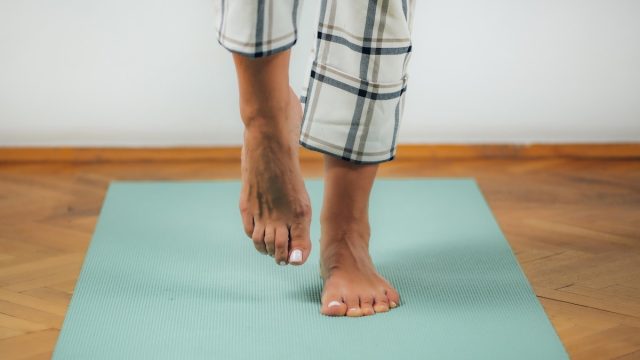If You Can Balance on One Leg for This Long, You’re in Great Shape, Doctors Say
It takes just half a minute to find out if you’re at higher risk of a fall.

As we age, we tend to (rightfully) put all the focus on maintaining a healthy diet and exercise routine. However, some of the most unexpected changes can come in how we safely move around and go about our days, making good stability key. And while we all might get caught up by accident every once in a while, doctors now say that you can easily tell you’re in great shape simply by testing how long you can balance on one leg.
RELATED: 8 Supplements You Should Never Take If You’re Over 60, Doctors Say.
Balance declines with age, research shows.
The latest findings come from a study published in the journal Public Library of Science (PLOS) One, which was conducted by a group of researchers from Mayo Clinic. The team organized 40 men and women aged 50 and older (half of whom were 65 or older) in good health.
The researchers then ran a series of tests to gauge each participant on several factors. This included measuring their walking gait by having them walk a half mile at their normal comfortable pace. They also had their upper and lower extremity strength gauged by performing grip and knee-extension assessments from a seated position, both on their dominant side.
The tests also included a balance check, in which each participant stood with both feet flat on the ground with their eyes open and then again with their eyes closed. Then, they tested their stability by lifting one foot and standing on each leg for at least 30 seconds, or until they lost equilibrium.
A final test was conducted that allowed participants to choose which leg stayed on the ground while they attempted to maintain balance. But in this case, they stood on a sensor platform that measured weight shifting while they tried to stand for as long as possible before putting their other foot down.
The researchers noted that there wasn’t a perceptible change in walking gait for participants of either sex, even as they got older. But there was a difference when it came to strength, with a “significant decline” detected with age.
This distinction also carried over to the balance tests. On average, participants could stand on their nondominant leg for roughly 17 seconds, but those aged 65 and older saw their average drop to just 11 seconds. Older participants also saw significantly more weight shifting in their planted foot.
RELATED: If You’re Getting Older, Eating This Fruit Can Prevent Muscle Loss, New Study Finds.
How long you can balance on one leg can determine healthy aging.
The team concluded that the duration you stand on one leg (regardless of biological sex) is the most important factor in determining aging compared to grip strength, lower extremity strength, or gait. Knowing this information can be vital to predicting and hopefully reducing the risk of injury.
“If you have poor balance, you’re more likely to fall,” Kenton Kaufman, PhD, a musculoskeletal research professor and the study’s senior author, said in an interview with The Washington Post.
But exactly how long should you be able to balance? “If you can’t stand on your leg for five seconds, you’re at risk of falls,” Kaufman explained. “If a person can stand on their leg for 30 seconds, they’re doing really well, especially if they’re older.”
This isn’t the first time researchers have seen a connection between balance and healthy aging. In a 2022 study published in the British Journal of Sports Medicine, scientists found that there was an 84 percent spike in the risk of death in seniors who couldn’t balance on one leg for 10 seconds within a seven-year follow-up window.
RELATED: If Your Grip Is This Strong, You’re in Great Shape, Doctors Say.
How to improve your balance as you age:
Fortunately, a decline in balancing ability isn’t an inevitability. Experts point out that certain exercises can help you maintain or even improve your balance in your senior years.
In a previous interview with Best Life, Andrea Lepcio, founder and owner of Mighty Fit, said some are especially simple single-leg exercises, such as “rock the boat.” It’s performed by standing on both legs and then slowly and steadily lifting one leg out to the side with the goal of holding it there for 30 seconds before returning it to the ground. Then, repeat the action on the other side, using a chair or wall for balance if you’re feeling unsteady at first, or adding a resistance band to increase difficulty.
She also suggests elements of yoga, such as tree pose, which involves placing one leg on the ground while placing the foot on your other leg against the standing leg. And you can also perform a simple balancing walk without any equipment.
“Walk forward slowly by placing the heel of one foot right ahead of the toe of the other foot. Step forward similarly, placing each foot right in front of the other,” Lepico previously told Best Life. “If you feel unsteady, walk closer to a wall so you can put your hand on the wall when uncertain. As you gain confidence, try slowly turning your head from side to side as you progress forward.”





















